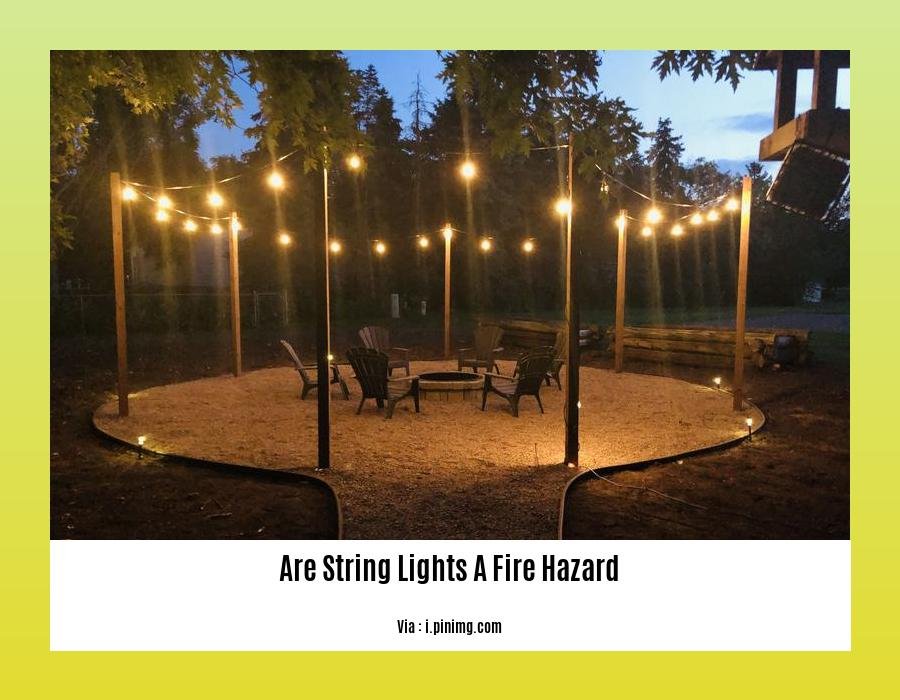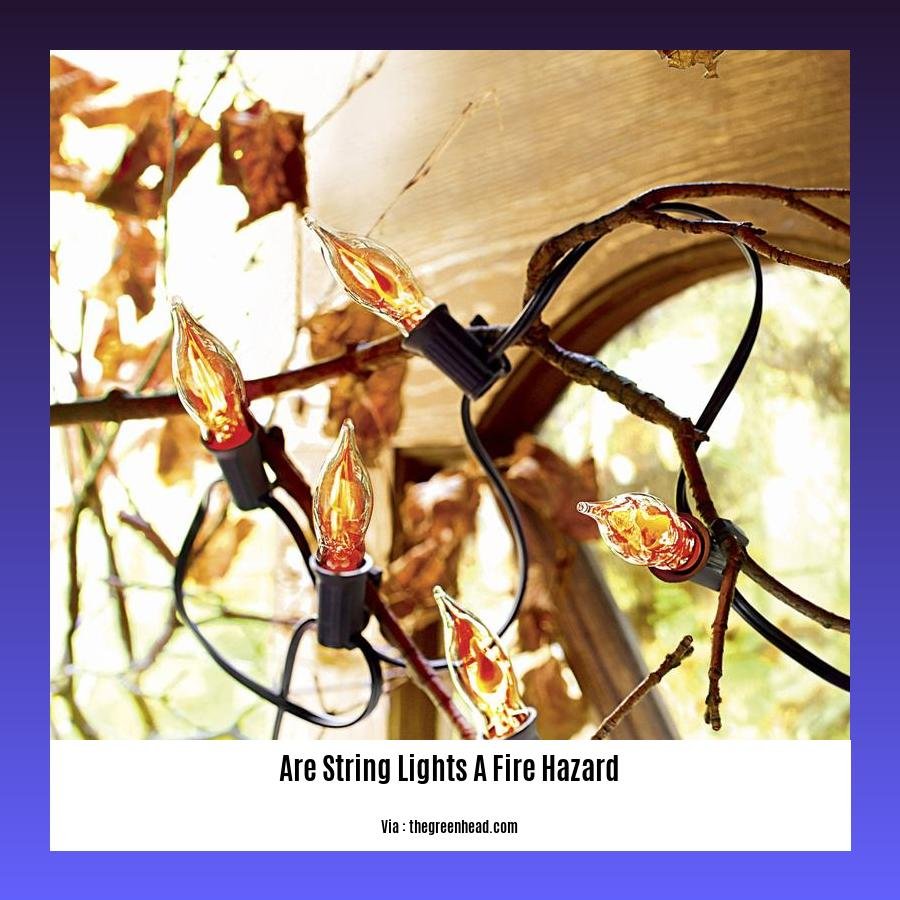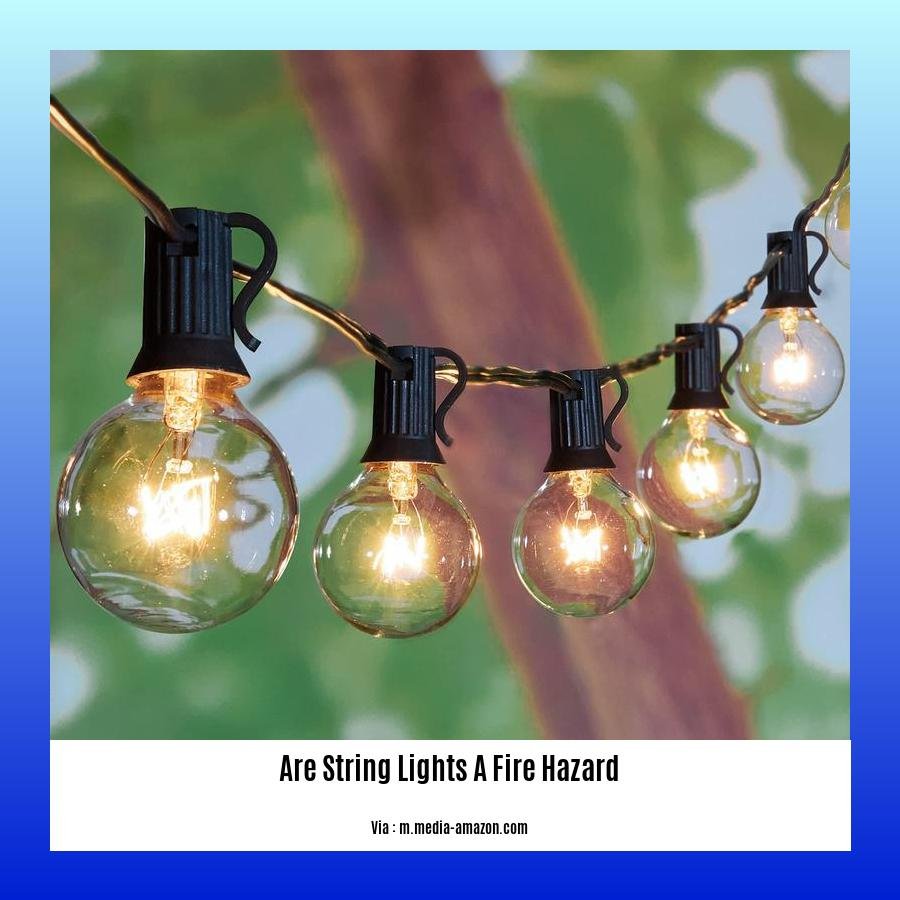Are string lights a fire hazard? Exploring the safety implications and precautions surrounding this popular lighting choice is crucial for ensuring the well-being of individuals and properties. As a fire safety specialist with years of expertise in identifying potential fire hazards, I aim to provide an informed perspective on the matter. In this article, we will delve into the potential risks associated with string lights and highlight important safety measures that can be taken to minimize the fire hazards they may pose.
Key Takeaways:
- String lights can be a fire hazard if used improperly.
- Indoor string lights must have a UL rating, indicating they have been tested and approved for safe use in homes.
- LED string lights are less likely to cause a fire compared to incandescent bulbs, as they generate less heat.
- It is important to handle and maintain LED string lights with care to prevent accidents like short circuits.
- Outdoor string lights themselves do not typically cause fires, but faulty wiring or installation can pose a fire hazard.
- Modern LED light bulbs are recommended over older incandescent bulbs as they consume less energy, emit less heat, and reduce the risk of overloading outlets.
- Using string lights with a UL rating and handling them properly can help limit the risk of fire.
Are String Lights a Fire Hazard? Exploring the Safety Implications and Precautions

Introduction:
String lights are a popular choice when it comes to adding a festive and cozy ambiance to our indoor or outdoor spaces. However, it’s crucial to consider the safety implications and potential fire hazards associated with their use. In this article, we will delve into the subject of whether string lights pose a fire hazard by examining important considerations and recommending safety measures to minimize any potential risks.
Understanding the Risks:
While string lights can undoubtedly enhance the aesthetics of a space, it is essential to acknowledge that they can be a fire hazard if used improperly. To comprehend this better, we need to explore the potential risks and distinguish between indoor and outdoor usage.
Indoor String Lights:
When it comes to using string lights indoors, there are a few key factors to consider to ensure fire safety.
1. UL Rating for Indoor String Lights:
It is crucial to choose indoor string lights that have a UL (Underwriters Laboratories) rating. This rating ensures that they have undergone stringent testing and have been approved for safe usage in homes. Be sure to check for this certification before purchasing.
2. LED vs. Incandescent Bulbs:
LED string lights are generally safer than those with incandescent bulbs. LED bulbs generate less heat, reducing the risk of a fire hazard compared to incandescent bulbs. When opting for string lights, consider choosing LED ones to minimize the potential danger.
3. Proper Handling and Maintenance:
Even with LED string lights, proper handling and maintenance are essential to prevent accidents such as short circuits. Adhere to the manufacturer’s guidelines regarding installation, usage, and maintenance. Avoid overloading outlets or using damaged cords, and always unplug them when not in use.
Outdoor String Lights:
Outdoor string lights themselves do not typically cause fires. However, there are specific safety measures to keep in mind when using them.
1. Faulty Wiring and Installation:
The main fire hazard associated with outdoor string lights is faulty wiring or installation. It is crucial to ensure that the wiring is correctly installed and protected from environmental elements such as rain, snow, or excessive heat. Inadequate wiring or improper installation can lead to short circuits and potential fire hazards.
2. Regular Inspection:
Regularly inspect the outdoor string lights, especially before and after the season of use. Look out for any signs of wear and tear, frayed wires, or any damage that may compromise the safety of the lights. Replace any damaged components promptly to maintain a safe outdoor lighting setup.
3. Consider LED Bulbs:
Similar to indoor usage, opting for LED bulbs in outdoor string lights is recommended. They generate less heat, consume less energy, and reduce the risk of overloading outlets. These benefits, combined with their increased durability, make LED bulbs a safer option for outdoor string lights.
Safety Measures to Minimize Fire Risks:
To ensure the safe use of string lights and minimize fire risks, it is important to follow these safety measures:
- Choose string lights with a UL rating for indoor use, indicating they have been tested and approved for safe usage.
- When possible, opt for LED string lights over those with incandescent bulbs to reduce heat generation and lower the risk of fire.
- Properly handle and maintain string lights by following the manufacturer’s guidelines for installation, usage, and storage.
- Avoid overloading electrical outlets and never exceed the recommended wattage for the string lights.
- Regularly inspect string lights for any signs of damage, such as frayed wires or broken bulbs, and replace or repair them promptly.
- Ensure outdoor string lights have proper wiring and are installed correctly, protecting them from environmental elements.
- When using outdoor string lights, avoid placing them near flammable materials and always turn them off when unattended or not in use.
By implementing these safety measures, you can enjoy the ambiance and beauty of string lights while minimizing the potential fire hazards they may pose.
Conclusion:
While string lights can undoubtedly create a delightful atmosphere, it is crucial to prioritize fire safety and take necessary precautions. By understanding the potential risks, using appropriate string lights with a UL rating, and following proper handling and maintenance procedures, you can ensure a safe and enjoyable experience with your string lights. Remember, vigilance and responsible usage are key to enjoying the ambiance without compromising safety.
Here are some captivating internal links for you:
-
Almond House Franchise Cost: Want to start your own almond house franchise? Find out the cost involved and kick-start your entrepreneurial journey today!
-
Are Fairy Lights a Fire Hazard: Curious about the safety of fairy lights? Discover whether or not they pose a fire hazard and keep your space beautifully illuminated with peace of mind.
-
Are Fairy Lights Safe to Leave on Overnight: Dreaming of a magical ambiance throughout the night? Learn if it’s safe to leave fairy lights on while you sleep and create a cozy atmosphere for your dreams.
-
Beach Furniture Near Me: Planning a day at the beach and need comfortable furniture? Explore the best beach furniture options near you and enjoy a relaxing and stylish seaside experience.
Examining Common Causes of String Light-Related Fires
String lights are a popular decorative element that adds a festive and cozy ambiance to any space. However, it’s important to be aware of the potential fire hazards associated with string lights to ensure the safety of your home or event. In this article, we will explore the common causes of string light-related fires and discuss precautions to mitigate these risks.
What Makes String Lights a Fire Hazard?
String lights have the potential to pose a fire hazard due to various factors. Understanding these factors can help you take preventive measures and ensure the safe use of string lights. Let’s take a closer look at the common causes of string light-related fires:
-
Overheating and Frayed Wires: String lights that are not rated for indoor use may overheat and catch fire. Additionally, the thin wires used in string lights can easily become damaged or frayed, increasing the risk of a fire hazard.
-
Overloading of Outlets: Plugging too many string lights into one outlet can overload the circuit and cause overheating, potentially leading to a fire.
-
Improper Grounding: An improperly grounded extension cord used to connect string lights can be a significant fire risk. According to a study conducted by the United States Department of Agriculture, string lights plugged into such extension cords may cause fires.
-
Exceeding Permissible Wattage: Using light fixtures that exceed the recommended wattage can generate excessive heat, increasing the likelihood of a fire hazard.
-
Single Wire Connection: If a string of Christmas lights has a single wire connection, the entire string can go out when one bulb goes bad. This can lead to voltage fluctuations and overheating, creating a fire risk.
-
Proximity to Flammable Materials: String lights should be kept away from flammable materials such as fabrics, paper, or flammable liquids. Accidental contact between these materials and the lights can ignite a fire.
-
Extended Use and Contact with Other Electronics: Leaving string lights on all night or using them in proximity to other electric devices without proper precautions can elevate the risk of overheating and potential fire hazards.
Precautions to Minimize Fire Risks
Now that we’ve examined the common causes of string light-related fires, let’s explore some precautions that can help minimize these risks:
-
Choose the Right Lights: When purchasing string lights, ensure they are rated for the intended use. Indoor string lights should have a UL rating for safe usage in homes.
-
Opt for LED Lights: LED string lights are generally safer than those with incandescent bulbs because they generate less heat. This reduces the risk of overheating and potential fire hazards.
-
Handle with Care: Properly handle and maintain string lights according to the manufacturer’s guidelines. Inspect them regularly for any wear and tear, and promptly replace damaged components.
-
Avoid Overloading Outlets: To prevent circuit overloads and overheating, avoid plugging too many string lights into a single outlet. Consider using power strips with built-in circuit breakers for added protection.
-
Properly Ground Extension Cords: When using extension cords for string lights, ensure they are properly grounded. Follow safety guidelines to reduce the risk of fire hazards.
-
Keep Lights Away from Flammable Materials: Place string lights away from combustible materials such as fabrics, paper, or flammable liquids. This reduces the chance of accidental contact and potential fire ignition.
-
Turn Off Lights When Not in Use: To minimize the risk of overheating and potential fire hazards, it is important to turn off string lights when they are not actively being used.
Key Takeaways:
- String lights can pose a fire hazard if not used correctly and safely.
- Overheating, frayed wires, overloading outlets, improper grounding, exceeding wattage, and proximity to flammable materials are common causes of string light-related fires.
- Precautions such as choosing the right lights, opting for LED lights, handling with care, avoiding overloading outlets, properly grounding extension cords, keeping lights away from flammable materials, and turning off lights when not in use can help minimize fire risks.
Sources:
1. Are String Lights a Fire Hazard? | Lights Den
2. Can String Lights Catch On Fire? (A guide to fire safety) – Captain Patio
[As an Experienced Fire Safety Specialist, Here Are Essential Tips and Safety Measures to Minimize the Risk of Fire When Using String Lights]
String lights have become a popular decorative choice for various occasions, adding a touch of warmth and ambiance to any setting. However, it’s essential to be aware of potential fire hazards associated with their use. As a seasoned fire safety specialist, I am dedicated to educating the public about fire prevention. In this article, I will explore important tips and safety measures to minimize the risk of fire when using string lights.
Ensuring Outdoor Approved Lights and Proper Extension Cord Usage
When using string lights outdoors, it’s crucial to choose outdoor-approved fairy lights, LED string lights, or Christmas lights. These lights are specifically designed and manufactured to withstand outdoor conditions and are less likely to pose fire hazards.
Moreover, always ensure that outdoor string lights are plugged into a waterproof and outdoor-rated extension cord. This cord should also have a UL rating to ensure safe usage in outdoor environments. The combination of outdoor-approved lights and a suitable extension cord significantly reduces the risk of fire incidents.
Consider the Benefits of LED Lights
LED string lights provide several advantages over traditional incandescent lights. While LED lights are generally not the primary triggers for fire incidents, it’s important to take note of their unique features. LED lights generate less heat, making them safer to use for extended periods. Additionally, LED lights consume less energy, making them more energy-efficient and reducing the risk of overloading outlets.
When using string lights in small and contained areas, LED lights are particularly recommended. Their low heat output and reduced energy consumption make them a suitable choice for indoor decorations and confined spaces.
Implement Effective Fire Safety Tips and Strategies
Implementing effective fire safety tips and strategies is crucial to minimize the risk of fires when using string lights. By following these essential tips and safety measures, you can ensure a safer environment:
-
Use a fire safety checklist: Regularly assess and address potential fire hazards related to string lights. By following a comprehensive checklist, you can identify potential risks and take appropriate measures to mitigate them.
-
Inspect and maintain regularly: Regularly inspect both indoor and outdoor string lights for signs of wear and tear. Replace damaged bulbs, frayed or broken wires, or faulty parts promptly. This proactive approach significantly reduces the risk of fire incidents.
-
Avoid overloading outlets: Overloading electrical outlets can lead to overheating and, consequently, fires. Follow proper usage instructions and avoid plugging too many string lights or other devices into a single outlet.
-
Manage heat dissipation: Ensure that string lights have enough space for proper heat dissipation. Avoid wrapping them tightly around combustible materials and keep a safe distance from flammable liquids, fabrics, or paper.
-
Follow usage restrictions: String lights, especially those designed for temporary use, should not be left on all night. Use caution when operating them near other electrical devices, as their combined usage can lead to overheating and fire hazards.
-
Proper storage and disposal: When not in use, store string lights properly in a cool, dry place. Avoid tangling the wires, as this can damage them. Furthermore, when disposing of string lights, follow the manufacturer’s guidelines or local regulations to ensure safe disposal.
By incorporating these tips and safety measures into your string light usage routine, you can significantly reduce the risk of fire hazards associated with their use.
Key Takeaways:
- Choose outdoor-approved fairy lights, LED string lights, or Christmas lights for outdoor use.
- Ensure outdoor lights are plugged into a waterproof and outdoor-rated extension cord.
- LED lights generate less heat and consume less energy, making them a safer option.
- Regularly inspect and maintain string lights for wear and tear, replacing any damaged components promptly.
- Avoid overloading outlets and follow usage restrictions.
- Keep string lights away from combustible materials and ensure proper heat dissipation.
- Use a fire safety checklist to assess and address potential fire hazards.
- Properly store and dispose of string lights to ensure safety.
Sources:
– Captain Patio – Can String Lights Catch On Fire? (A guide to fire safety)
– LED Lights Central – Can LED Lights Cause Fire? Answered
The Importance of Regular Maintenance and Inspection in Preventing Fire Incidents

The safety of our homes and businesses is a top priority, and it’s important to be aware of potential fire hazards. When it comes to ensuring the safety of our lighting choices, many people wonder if string lights pose a fire hazard. In this article, we will explore the safety implications of string lights and discuss important considerations and potential safety measures to minimize fire risks.
String lights can add a beautiful ambiance to any space, whether indoors or outdoors. However, it is crucial to ensure that these lights are used safely to prevent fire incidents. Regular maintenance and inspection play a vital role in maintaining the safety of string lights and preventing potential fire hazards.
Regular Inspections:
Regular inspections are essential for identifying any issues or signs of wear and tear that can increase the risk of fire incidents. By conducting routine inspections, you can catch problems early on and address them promptly. Inspect the wiring, plugs, and bulbs of your string lights to ensure they are in good condition. Look for any frayed wires, loose connections, or damaged components. If you notice any issues, it’s important to replace or repair them immediately.
Proper Maintenance:
Proper maintenance is key to ensuring the safe use of string lights. Follow the manufacturer’s guidelines for installation, usage, and maintenance. Avoid overloading outlets by plugging in too many string lights or other devices. Overloading can lead to overheating and potentially cause a fire. Additionally, turn off string lights when not in use to minimize the risk of electrical issues.
Safety Precautions:
To further minimize fire risks associated with string lights, consider taking the following safety measures:
- Indoor string lights should have a UL rating for safe usage in homes.
- LED string lights are safer than those with incandescent bulbs because they generate less heat.
- Regularly inspect string lights for wear and tear and replace damaged components promptly.
- Outdoor string lights can pose a fire hazard due to faulty wiring or installation. Ensure they are properly installed and follow safety guidelines.
- Consider using LED bulbs for outdoor string lights as they generate less heat and consume less energy.
- Avoid placing string lights near flammable materials such as fabrics, paper, or liquids.
- Ensure string lights are not left on for extended periods, especially overnight.
- If using an extension cord, make sure it is outdoor-rated and properly grounded.
- Always handle and store string lights with care to avoid damage to the wires.
By following these important safety measures and conducting regular maintenance and inspections, you can minimize the risk of fire hazards associated with string lights. Remember, prevention is key when it comes to fire safety, and taking proactive steps can help protect your home or business from potential fire incidents.
Key Takeaways:
– Regular inspections and maintenance are crucial in preventing fire incidents related to string lights.
– Inspect for frayed wires, loose connections, or damaged components.
– Follow manufacturer’s guidelines for installation, usage, and maintenance.
– Avoid overloading outlets and turn off string lights when not in use.
– Indoor string lights should have a UL rating, and LED bulbs are safer than incandescent bulbs.
– Outdoor string lights require proper installation and should be kept away from flammable materials.
– Consider using LED bulbs for outdoor string lights and use outdoor-rated and properly grounded extension cords.
– Handle and store string lights with care to avoid damage to the wires.
Sources:
– Lights Den – Are String Lights a Fire Hazard?
– Captain Patio – Can String Lights Catch On Fire? (A guide to fire safety)
FAQ
Q1: Are string lights safe to use indoors?
A1: String lights can be safe to use indoors if they have a UL rating, indicating they have been tested and approved for safe use in homes. It is important to follow safety protocols, handle them properly, and avoid plugging in damaged strands to minimize the risk of fire hazards.
Q2: Do LED string lights pose a fire hazard?
A2: LED string lights are generally less likely to cause a fire compared to incandescent bulbs, as they generate less heat. However, it is still important to handle and maintain LED string lights with care to prevent accidents like short circuits. Using LED lights and ensuring they are in good condition can help reduce the risk of fire hazards.
Q3: Can outdoor string lights cause fires?
A3: Outdoor string lights themselves do not typically cause fires. However, faulty wiring or improper installation of outdoor string lights can pose a fire hazard. It is important to use string lights that are rated for outdoor use and to ensure they are plugged into a waterproof and outdoor-rated extension cord to minimize the risk of fire hazards.
Q4: How can I reduce the risk of fire when using string lights?
A4: To reduce the risk of fire when using string lights, it is recommended to choose outdoor-approved fairy lights, LED string lights, or Christmas lights. Additionally, it is important to follow usage restrictions, such as not leaving the lights on all night, and keep the lights away from combustible materials. Regularly inspecting the lights, avoiding overloading outlets, and properly storing and disposing of them can also help ensure safety.
Q5: What are the potential fire hazards associated with string lights?
A5: Potential fire hazards associated with string lights include using lights that are not rated for indoor use, plugging too many lights into one outlet, and using string lights with damaged or frayed wires. Overloading outlets, using improper light fixtures, and plugging lights into improperly grounded extension cords can also increase the risk of fires. It is important to handle and maintain string lights properly, keep them in good condition, and follow safety guidelines to minimize fire hazards.
Are String Lights a Fire Hazard? Exploring the Potential Risks and Safety Measures
Are string lights a fire hazard? This article delves into the potential risks and safety measures associated with string lights to provide a comprehensive assessment of their fire hazards. As a seasoned fire safety expert with extensive experience in fire prevention and risk assessment, I bring in-depth knowledge and practical insights regarding electrical fire risks. With a focus on identifying potential fire hazards, analyzing electrical systems, and advising on preventative measures, this article explores the safety considerations that need to be taken into account when using string lights.
Key Takeaways:
- String lights can pose a fire hazard if not used properly.
- Indoor string lights should have a UL rating to ensure safe use in residential settings.
- LED string lights produce less heat and are less likely to cause fires compared to incandescent bulbs.
- Proper handling and maintenance of string lights are crucial to prevent short circuits and accidents.
Are String Lights a Fire Hazard? Exploring the Potential Risks and Safety Measures
String lights have become a popular decorative choice for many homeowners and are commonly used during festive occasions or to create ambient lighting in indoor and outdoor spaces. While they can add charm and create a cozy atmosphere, it is important to consider the potential fire hazards associated with string lights. In this article, we will delve into the risks posed by string lights and discuss safety measures to ensure their safe use.
Understanding the Risks
Improper use of string lights can indeed pose a fire hazard. One of the key factors to consider when evaluating the safety of string lights is the presence of a UL (Underwriters Laboratories) rating. UL ratings indicate that the product has undergone rigorous testing and meets safety standards. For indoor string lights to be considered safe for home use, they should have a UL rating, ensuring that they have been designed and manufactured to meet specified safety standards.
Incandescent bulbs, commonly used in traditional string lights, generate a significant amount of heat. This excessive heat production combined with prolonged use can increase the risk of a fire hazard. However, with advancements in lighting technology, LED string lights have emerged as a safer alternative. LED bulbs generate less heat, reducing the likelihood of a fire caused by overheating. Opting for LED string lights can significantly minimize the fire risk associated with string lights.
Safety Measures for Using String Lights
To ensure the safe use of string lights and minimize the risk of fire hazards, it is important to follow certain precautions and safety measures:
-
Inspect and Maintain: Regularly inspect your string lights for any signs of wear and tear, including frayed wires or broken sockets. Replace any damaged components promptly to prevent short circuits and potential fire hazards.
-
Safe Indoor Use: When using string lights indoors, make sure to choose ones specifically designed for indoor use. These lights are typically built with materials that can withstand the conditions indoors and have lower fire risks.
-
Outdoor Considerations: If you plan to use string lights outdoors, ensure that you select lights specifically designed for outdoor use. These lights are typically weatherproof and built to withstand exposure to elements such as rain or snow. Additionally, it is crucial to keep the electrical connections protected from moisture and use a ground fault circuit interrupter (GFCI) outlet for added safety.
-
Mindful Placement: Avoid placing string lights near flammable materials such as curtains, furniture, or decorations. Keep them away from any potential sources of ignition to minimize the risk of fire.
-
Timers and Controlled Use: Using timers or smart plugs can help control the duration of string light usage, preventing them from being left unattended for extended periods. This reduces the chances of overheating and minimizes the fire risk.
-
Proper Storage: When not in use, store your string lights properly in a dry and cool place, away from any potential damage or exposure to moisture. This helps maintain their integrity and reduces the risk of electrical malfunctions.
By incorporating these safety measures, you can enjoy the warmth and beauty of string lights while minimizing the potential fire hazards associated with their use.
Conclusion
While string lights can undoubtedly enhance the visual appeal of any space, it is crucial to be aware of their potential fire hazards. By choosing UL-rated lights and opting for LED bulbs, inspecting and maintaining your lights diligently, and following safe usage guidelines, you can significantly reduce the risk of fire. Remember, adhering to proper safety measures is essential to ensure the enjoyment of string lights without compromising on safety. So go ahead, create a cozy and inviting ambiance with string lights, keeping in mind the importance of fire prevention and risk assessment. Stay safe and enjoy the magical glow of string lights responsibly!
Looking to start your own Almond House franchise? Check out the franchise cost for Almond House here: almond house franchise cost
Concerned about the safety of using fairy lights? Find out if fairy lights are a fire hazard: are fairy lights a fire hazard
Wondering if it’s safe to leave your fairy lights on overnight? Learn more about the safety of leaving fairy lights on: are fairy lights safe to leave on overnight
Planning a beach day and in need of furniture? Explore the options for beach furniture near you: beach furniture near me
Common Causes of String Light Fires
String lights can add a magical touch to any space, but it’s essential to understand the potential fire hazards they can pose if not used properly. By familiarizing yourself with the common causes of string light fires, you can ensure both safety and enjoyment. Let’s explore these causes and discover how to minimize the risks associated with string lights.
Overloading Electrical Circuits:
One of the most common causes of string light fires is overloading electrical circuits. When too many lights are connected to a single outlet or extension cord, it can lead to overheating and potentially spark a fire. It is crucial to follow the manufacturer’s recommendations for the maximum number of lights that can be connected in a series and avoid exceeding that limit. Additionally, using surge protectors and avoiding daisy-chaining multiple extension cords can help distribute the electrical load and reduce the risk of overloading.
Damaged or Faulty Wiring:
Another significant cause of string light fires is damaged or faulty wiring. Over time, the wires in string lights can become frayed, exposing the electrical components and increasing the likelihood of a short circuit. It’s essential to regularly inspect your string lights for any signs of wear and tear, such as broken or exposed wires. If you notice any damage, it is crucial to replace the lights or repair them before using them again to prevent fire hazards. Additionally, always ensure that the bulbs are securely connected to the sockets to avoid loose connections that can generate heat.
Improper Use and Placement:
Using string lights inappropriately or placing them near potential sources of ignition can also increase the risk of fire. It is important to avoid placing string lights near flammable materials, such as curtains, fabrics, or paper. The heat generated by the bulbs can ignite these materials and lead to a fire. Always maintain a safe distance between the lights and any potential flammable objects. Additionally, never attach string lights with staples or nails that can damage the wiring. Instead, use appropriate clips or hooks designed for string lights to secure them safely.
Overheating due to Prolonged Use:
Leaving string lights on for an extended period, especially overnight, can cause them to overheat and potentially start a fire. It’s important to use timers or smart plugs to control the duration of string light usage, ensuring they are not left unattended for too long. Additionally, choosing LED string lights over traditional incandescent lights can reduce the risk of overheating. LED lights generate less heat and are a safer alternative, especially when used for extended periods.
Weather Exposure:
When using string lights outdoors, it’s crucial to consider the weather conditions. Rain, snow, or high humidity levels can compromise the safety of the lights and increase the risk of electrical malfunctions. Ensure that the string lights you use for outdoor purposes are specifically rated for outdoor use and are designed to be weatherproof. It is also essential to protect the electrical connections and keep them away from moisture to minimize the risk of short circuits and potential fires.
Key Takeaways:
– Overloading electrical circuits can lead to string light fires, so follow the manufacturer’s recommendations for the number of lights in a series and avoid daisy-chaining too many extension cords.
– Inspect string lights regularly for damaged or faulty wiring, such as frayed wires or loose connections. Replace or repair any damaged components promptly.
– Place string lights away from flammable materials and potential sources of ignition to reduce the risk of fire hazards.
– Control the duration of string light usage with timers or smart plugs to avoid overheating.
– Use outdoor-rated and weatherproof string lights when decorating outside to ensure safety in different weather conditions.
Sources:
– Captain Patio: Can String Lights Catch On Fire? (A guide to fire safety)
– Lights Den: Are string lights a fire hazard?
Preventive Measures to Reduce Fire Risks
When it comes to string lights and their potential fire hazards, it’s important to prioritize safety and take preventive measures to minimize the risk of fires. By implementing these precautions, you can enjoy the beautiful ambiance string lights provide while keeping your home and loved ones safe. Let’s explore some key preventive measures you can take to reduce fire risks:
1. Choose the Right Type of String Lights
- Opt for LED lights: LED string lights are a safer option as they generate less heat compared to traditional incandescent lights. This significantly reduces the risk of heat-related fire hazards.
2. Keep String Lights Away from Combustible Materials
- String lights should be kept away from flammable liquids, fabrics, and paper. Ensure a safe distance is maintained between the lights and any potential sources of ignition.
3. Follow Usage Restrictions
- It is important to adhere to the recommended usage restrictions provided by the manufacturer. Leaving string lights on for extended periods, especially overnight, can increase the risk of overheating and potential fire hazards.
4. Consider Outdoor Use Safely
- If you are using string lights outdoors, particularly in wet conditions like rain or snow, make sure they are specifically designed for outdoor use and can withstand moisture. Check the manufacturer’s specifications and ensure they are suitable for such environments.
5. Regularly Inspect and Maintain String Lights
- Regularly inspect string lights for any signs of wear and tear, such as frayed wires or damaged bulbs. Replace any damaged components promptly to prevent electrical malfunctions that can lead to fire hazards.
6. Properly Store String Lights
- When not in use, it’s essential to store string lights properly. This helps reduce the risk of electrical malfunctions and damage that could result in fire hazards. Keep them in a cool, dry place to prolong their lifespan and maintain their safety.
7. Consider Battery-Operated LED Lights
- If you’re unable to install traditional lighting fixtures or have concerns about electrical sparks, battery-operated LED lights can be a safer alternative. These lights eliminate the need for wiring or outlets, reducing the risk of electrical fire hazards.
8. Be Mindful of Heat Dissipation
- Different types of string lights have varying heat outputs. It is crucial to consider the heat dissipation of the lights you choose. LED lights generate minimal heat, making them a safer option compared to incandescent lights, which can become hot and potentially ignite flammable materials.
By following these preventive measures to reduce fire risks, you can safely enjoy the decorative charm of string lights in your home or outdoor spaces. Remember, taking precautions and prioritizing fire safety is essential to protect yourself, your loved ones, and your property.
Key Takeaways:
- Opt for LED lights due to their lower heat output compared to incandescent lights.
- Maintain a safe distance between string lights and flammable materials.
- Follow manufacturer guidelines and usage restrictions to prevent overheating.
- Use outdoor string lights specifically designed for wet environments.
- Regularly inspect for wear and tear, replacing damaged components promptly.
- Store string lights properly when not in use to minimize electrical malfunctions.
- Consider using battery-operated LED lights as a safer alternative.
- Be mindful of heat dissipation, with LED lights posing a lower fire risk than incandescent lights.
Sources:
Captain Patio: Can String Lights Catch On Fire?
Lights Den: Are string lights a fire hazard?
The Importance of Regular Maintenance and Inspections
Outdoor string lights are a beautiful and popular way to enhance the ambiance of outdoor spaces. However, it is important to be aware of the potential fire hazards associated with these lights. To ensure the safety of your string lights and prevent fire risks, regular maintenance and inspections are crucial.
Why is Regular Maintenance Important?
Regular maintenance is essential to keep your string lights in good working order and minimize the risk of fire hazards. Over time, outdoor conditions can cause wear and tear on the lights, such as exposure to moisture, wind, and extreme temperatures. Regular maintenance allows you to identify and address any potential issues before they become serious safety concerns.
The Importance of Inspections
Inspections play a vital role in ensuring the safety of your string lights. By regularly inspecting your lights, you can identify any signs of damage or wear that may pose a fire hazard. Inspections should cover various aspects, including the wiring, bulbs, and any connectors or attachments. It is important to pay close attention to frayed wires, loose connections, or any signs of overheating.
Maintaining Safe Conditions
During maintenance and inspections, it is important to focus on creating and maintaining safe conditions for your string lights. Here are some key points to consider:
- Choose bulbs that are rated for outdoor use and have the appropriate safety certifications.
- Keep your string lights at a safe distance from any flammable materials, such as fabrics, paper, or liquids.
- Avoid leaving string lights on overnight or for extended periods to prevent overheating and potential fire hazards.
- Ensure that your string lights are properly installed and securely mounted.
By regularly maintaining and inspecting your string lights, you can ensure their safety and minimize the risk of fire hazards. Remember to prioritize safety and follow the manufacturer’s guidelines for installation and usage. With proper maintenance and inspections, you can enjoy the beauty and ambiance of outdoor string lights while keeping your surroundings safe.
Key Takeaways:
- Regular maintenance and inspections are crucial to ensuring the safety of outdoor string lights.
- Maintenance helps identify and address potential issues before they become serious safety concerns.
- Inspections should cover all aspects of the lights, including wiring, bulbs, and connectors.
- Choose bulbs rated for outdoor use and keep the lights at a safe distance from flammable materials.
- Avoid leaving string lights on for extended periods and ensure proper installation.
FAQ
Q1: Can string lights catch on fire?
A1: Depending on the type of string lights being used, there is a potential risk of fire. LED lights are generally considered low risk as they do not generate much heat, but incandescent lights can become hot and ignite flammable materials. It is important to follow safety guidelines and avoid placing string lights near combustible materials.
Q2: Are indoor string lights safe to use?
A2: Indoor string lights that have a UL rating are considered safe for use in the home. The UL certification ensures that the lights meet safety standards and have necessary safety measures in place to prevent fires. It is important to choose string lights that are specifically rated for indoor use to minimize fire hazards.
Q3: Can outdoor string lights cause a fire?
A3: Yes, outdoor string lights can potentially cause a fire if they are not installed or maintained properly. It is important to follow installation instructions, choose bulbs that are rated for outdoor use, and keep the lights at a safe distance from flammable materials. Outdoor string lights should also be suitable for use in wet environments to prevent fire hazards.
Q4: What are the risks of leaving string lights on all night?
A4: Leaving string lights on overnight can increase the risk of fire hazards. Overheating can occur if the lights are left on for an extended period of time, especially if they are old or damaged. It is advisable to follow manufacturer guidelines regarding usage duration and turn off string lights when not in use to minimize fire risks.
Q5: Are battery-operated LED lights a safer alternative to string lights?
A5: Battery-operated LED lights can be a safer alternative to traditional string lights. These lights eliminate the risk of electrical sparks and can be used both indoors and outdoors without the need for wiring or outlets. However, it is still important to handle and maintain battery-operated lights with care to prevent short circuits and accidents.
- How to Get Rid of Mushrooms in Your Lawn: A Complete Guide - April 24, 2025
- How to Get Rid of Ground Hornets: A Safe and Effective Guide to Eliminating Nests - April 24, 2025
- How to Get Rid of German Roaches Fast: DIY Methods for Quick Control - April 24, 2025










